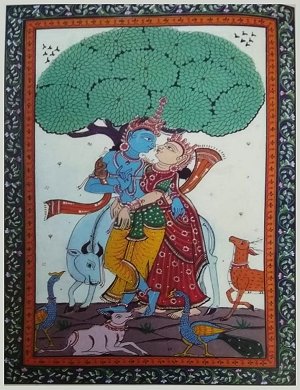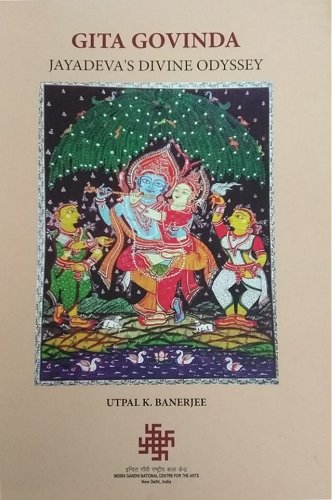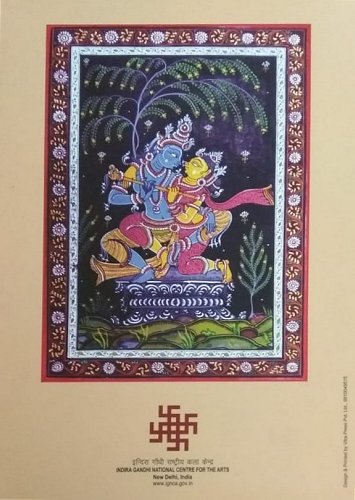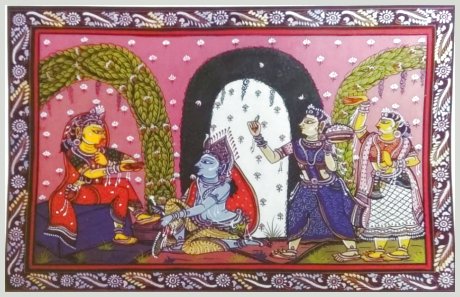
|   |

|   |
 e-mail: ukb7@rediffmail.com How Gita Govinda colored my life Patachitras courtesy: Dr. Subas Pani September 14, 2021 Pralaya payodhi jale dhrita vanasi Vedam / Bihita bahitra charitrama khedam / Keshava dhrita Meena shareera / Jaya Jagadisha Hare!...thus penned Jayadeva to commence his Gita Govinda. Jayadeva was the court-poet of the Emperor Lakshmana Sen in Sen Dynasty of Eastern India. This happened in the 12th century when Jayadeva was one of the Pancha Ratnas (Five Jewels) in the royal court. And immediately, the whole of India (and Nepal) was enamoured. Both the cognoscente and the hoi polloi were equally captivated -- enchante, charme, rave, as they would say in French, i.e., "enchanted, charmed, ravished!" Eight centuries have passed since and Jayadeva's 72 Prabandhas (songs) culled under 12 Sargas (cantos) in his epic were so "word perfect" that not one accent has been altered, not one syllable changed, not one line deleted during all this time -- much unlike many other lofty treatises. Meanwhile, dancers have danced to his Ashtapadis, musicians set their music to his ragas or to new innovative ones, painters draw on his epic saga of the Radha-Krishna love play - the globally famous "Kishengarh Radha" being a supreme example - and sculptors created superb art works on the Gita Govinda legends, apart from numerous epitomes having been written on the meaning and interpretation of the epic, including Kapila Vatsyayan's erudite, lifetime studies on the same.  How 'yours truly' chanced upon the onerous task of translating the epic into fully rhymed English verse has a small story behind it. Before the years 2011-12, when Tagore's 150th birth centenary was due to be observed, the national Sahitya Akademi asked me to try translating the "nonsense rhymes" of Tagore. Now, a la Ogden Nash, Edward Lear and Lewis Carroll, Tagore too loved the hyperboles and metaphors used in children's lore and turned them into exquisite, witty lines of verse for children and adults alike. Unfortunately, these poems were apparently not much thought of, by the literary circles and did not go much beyond the Bengali children's world. I, however, jumped on the idea and soon came back to SA with four thematic volumes: Humour and Satire; Mother and Child; Wish Fulfillment Foray and Fantasy Poetry. The then Secretary of SA lovingly put them together in a two-language version and suggested a portmanteau title - Rainbow Rhymes of Tagore. Illustrated with Tagore's own and Nandalal Bose's drawings and moderately priced, the hardbound edition had apparently proved immensely popular! So much so that some very well-known classical dancers of Delhi did something that classical dancers of Kolkata had seldom done with Tagore's original nonsense rhymes --- they took up my English versions and fully using their "creative freedom", interpreted some of the poems with their own choreography. Thus, around September 27 (my birthday) in 2014, they held a programme at India Habitat Centre (IHC), with Shovana Narayan dancing in Kathak style; SarojaVaidyanathan, Rama Vaidyanathan and Dakshina Vaidyanathan in Bharatanatyam style; Bharati Shivaji in Mohiniyattam style; and Santosh Nair in both contemporary and Chhau styles. With Sadhana Srivastava doing the narrative in her impeccable style, the programme was a dance sensation and done without charging any money; it was their tribute to my attaining 80th year! Not to fall behind, India International Centre (IIC) took up the cudgels in 2015 and again around September 27 (my touching 81), invited a galaxy of noted dancers to hone their "creative freedom" and interpret another bouquet of my Tagore's verse translations: young Purvadhanashree using Vilasini Natyam style; Kavita Dwivedi using Odissi style; Prathibha Prahlad using Bharatanatyam style; and Saswati Sen using Kathak style; and Pt. Birju Maharaj doing the honour of felicitating the artistes. Again done gratis, it was a dancing sensation of the season! While, fully charged, I was pressing ahead with a three language version of Tagore's 300 songs --under individual titles of Mystic Songs of Tagore; Romantic Songs of Tagore and Patriotic Songs of Tagore with a hundred songs in each volume (for Abhinav Publications) - some dancer-friends came over to ask me why didn't I do a similar English poetry version of Jayadeva's Gita Govinda? When I looked back at them quizzically, they explained that while they frequently interpreted Jayadeva's Ashtapadis in their individual classical dance forms, they had invariably to fall back upon the English prose translations of Gorge Keyt and others for gleaning the meaning of the original Sanskrit poetic text. A convenient rhymed verse translation of Gita Govinda would do them a world of good! Convinced, I began looking at Jayadeva, when I was hooked -- for the rest of my life - with his profusion and command over Mandakranta rhyming scheme! Let me quickly explain. Sanskrit poetry is very rich in its use of a plethora of rhyming schemes, but the most common form is Payar, with eight metres. Here is an example from Srimad Bhagavad Gita: Duhkheshanu udvignamanah sukheshu bigataspriha / Beetaraga vayakrodhah sthithadhee muni ruchyate... This one is from the second chapter. And here is a gem from the same Gita in Mandakranta this time: Vasangsi jirnani yatha vihaya navani grinhati naroparani / Tatha sharirari vihaya jirnanyani sanjati navani dehi... What a profound message, yet couched in what a musical mode, what lilt, what melody! When I looked up Kalidasa, I found a similarly glittering rhymed gem: Duradayashchya kranivaswa tanvi tamalatali vanaraji neela / Avati bela neelamburashirdhara nivaddheva kalanka rekha... It was the great poet's panoramic view of the sprawling high seas with what magical words! I found Jayadeva abounding just in Mandakranta, with only some occasional Shardula Vikreetam, but never any Payar. Here is a well known example: Lalita lavanga lata parisheelana komala malaya sameere / Madhukaraneekara karambhita kokila kujita kunja kutire. This is how Radha's companions adorned their Sakhi's abode with flowers for the evening love tryst with Krishna. Here is another instance of a woman scorned as the veritable hell aroused! Ya hi Madhava! Ya hi Keshava! Ma vada kaitava vadam / Taam anusara sarasiruha lochana Ya tava haroti vishadam! This is an enraged Radha confronting a truant Krishna after a futile night long wait! I was taken in right and proper and the outcome is my English verse translation: Gita Govinda: Jayadeva's Divine Odyssey.   Let me concede that I had a model: the 1859 publication of Rubaiyat of Omar Khayyam, edited by Edward Fitzgerald. This book contained exquisite rhymed verse translations of the famous 10th century Persian poet Omar Khayyam's work. Fitzgerald's book went into immediate fame adapted all over the world in every language and always decorated with illustrations of the Persian poet, accompanied "by a book of verse and a jug of wine", and, of course, by his ravishingly pretty ladylove! There was one most vital difference though between Fitzgerald and me. The former had taken the Persian Rubais which were all dohas (2-liners) and expanded them into chaupais (4-liners). Obviously, the meaning had to be stretched and, as Fitzgerald himself confessed, often heavily embellishing and altering the essence by what he termed "transmongrification"! Au contraire, as in French, i.e., "to the contrary", I most assiduously avoided taking any liberty whatsoever and tried my very best to remain truthful to the original- with similar rhyming scheme, even alliterations and the internal rhymes. As regards meaning, I trusted at least four sources of my prose predecessors, to check the same. The result is there, for all to see. IGNCA has done a magnificent job of four-colour printing and opened their vast and rich archives to decorate the book with a profusion of wonderful -Phad' miniatures, in addition to the few -Patachitras' from Odisha.  In fine, I go back to Jayadeva: Kuru yadu nandana chandana shishire tarena karena payodhare... which was once danced by Pt. Birju Maharaj as Krishna and Kelucharan Mohapatra in the eastern metropolis and left an indelible impression on my mind. Here is my obeisance to Yadunanda and the immortal poet Jayadeva of yesteryears who sung his paeans of praise, and to an epic that is bound to be sung and danced and painted and sculpted for centuries to come!  Dr. Utpal K Banerjee is a scholar-commentator on performing arts over last four decades. He has authored 23 books on Indian art and culture, and 10 on Tagore studies. He served IGNCA as National Project Director, was a Tagore Research Scholar and is recipient of Padma Shri. Comments * I read your piece and thoroughly enjoyed it. To write on an event concerning one's own work is not easy and you have treated it with a light seriousness - if there is such a state. In fact, I had never thought that anything like what you have tried out in your latest book could be attempted. Looking forward to your next enterprise. - Leela Venkataraman (Sept 19, 2021) Post your comments Pl provide your name and email id along with your comment. All appropriate comments posted with name and email id in the blog will also be featured in the site. |